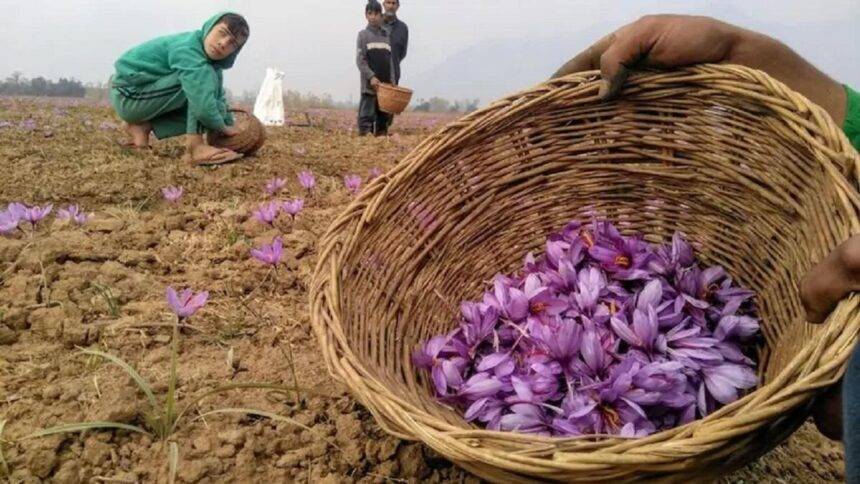Main Points In Hindi (मुख्य बातें – हिंदी में)
-
सफेद कश्मीर का सुंदरता: कश्मीर अपनी सुंदरता के अलावा, दुनिया के सबसे महंगे मसाले, केसर की खेती के लिए भी जाना जाता है। पंपोर इसे ‘केसर का कटोरा’ कहा जाता है, जहां इस मसाले की सबसे अधिक खेती होती है।
-
उत्पादन में गिरावट: अक्टूबर-नवंबर के दौरान केसर की कटाई के समय, वर्षा की कमी के कारण केसर का उत्पादन लगभग 50 प्रतिशत घट गया है। सफ़रन एसोसिएशन कश्मीर के अध्यक्ष, अब्दुल मजीद वानी के अनुसार, पिछले साल उनके खेत ने 70 किलोग्राम केसर उत्पादित किया था, जो अब 35-40 किलोग्राम रह गया है।
-
वित्तीय सहायता की मांग: विशेषज्ञ जी. एम. पम्पोरी का कहना है कि कम उत्पादन के पीछे कई कारण हैं, जिसमें जल आपूर्ति के लिए कार्यशील बोरवेल की कमी भी शामिल है। उन्होंने राष्ट्रीय केसर मिशन (एनएमएस) के तहत अधिक फंड की मांग की है।
-
कृषि विभाग डेटा का संकलन कर रहा है: मौसम विभाग ने भी हाल के महीनों में घाटी में बहुत कम वर्षा की बात कही है। कृषि विभाग ने कहा है कि इस मौसम के केसर के उत्पादन का डेटा एक सप्ताह के भीतर उपलब्ध होगा।
- जीआई टैग मिला: 2020 में कश्मीरी केसर को जीआई टैग दिया गया था और प्रधानमंत्री नरेंद्र मोदी ने इसे विश्वस्तरीय ब्रांड बनाने के लिए काम करने की बात की है।
Main Points In English(मुख्य बातें – अंग्रेज़ी में)
Here are the main points from the provided text:
-
Saffron Production Decline: The saffron cultivation in Kashmir, particularly in Pampore (known as the ‘Saffron Bowl’), has experienced a significant decline in production, with estimates showing a drop of about 50% due to insufficient rainfall during the growing season.
-
Impact on Farmers: Farmers, represented by Abdul Majeed Wani of the Saffron Association Kashmir, are expressing disappointment over low yields, with one farm’s production decreasing from 70 kg last year to approximately 35-40 kg this year.
-
Need for Irrigation Solutions: Experts, including GM Pampori, highlight the lack of functional borewells for irrigation as a major factor contributing to low saffron production. They are calling for increased financial assistance under the National Saffron Mission (NMS) to support saffron growers.
-
Upcoming Production Data: The Agriculture Department is in the process of collecting data on saffron production for the current season, with results expected to be released soon, amidst reports of exceptionally low rainfall in the valley.
- Recognition and Innovations: Kashmiri saffron was granted a geographical indication (GI) tag in 2020 to enhance its branding, and new cultivation methods, like aeroponic technology, are being explored to expand saffron farming in various climates, despite higher initial costs.


Complete News In Hindi(पूरी खबर – हिंदी में)
कश्मीर अपनी सुंदरता के साथ-साथ दुनिया के सबसे महंगे मसालों में से एक, केसर की खेती के लिए भी जाना जाता है। यहां केसर की सबसे अधिक खेती पंपोर में होती है, इसलिए इसे कश्मीर का ‘केसर का कटोरा’ भी कहा जाता है। वर्तमान में केसर तोड़ने का समय चल रहा है (अक्टूबर-नवंबर), लेकिन कम बारिश के कारण इसकी उत्पादन में भारी कमी आई है। हालांकि पिछले दो वर्षों में यहां केसर का उत्पादन संतोषजनक रहा है, किसानों को उपज के कारण निराशा हुई है।
उत्पादन में 50 प्रतिशत की कमी
केसर एसोसिएशन कश्मीर के अध्यक्ष अब्दुल मजीद वानी 2500 किसानों का प्रतिनिधित्व करते हैं। उन्होंने ‘द ट्रिब्यून’ को बताया कि केसर तोड़ने का काम लगभग पूरा हो गया है, लेकिन अब तक की रिपोर्ट के अनुसार, कम बारिश की वजह से उत्पादन में करीब 50 प्रतिशत की कमी आई है। अब्दुल मजीद वानी ने बताया कि उनके अपने खेत में पिछले साल लगभग 70 किलोग्राम केसर हुआ था, जबकि इस साल यह 35-40 किलोग्राम रह गया है।
आर्थिक सहायता बढ़ाने की मांग
केसर की खेती के विशेषज्ञ जीएम पामपोड़ी ने कम उत्पादन के पीछे कई कारण बताए हैं। उन्होंने कहा कि सिंचाई के लिए कार्यशील बोरवेल की कमी भी एक बड़ा कारण है। उन्होंने कहा कि यदि अधिकारियों ने चाहा होता, तो बोरवेल के जरिए कम बारिश के कारण होने वाली पानी की कमी को पूरा किया जा सकता था। जीएम पामपोड़ी ने केसर उत्पादकों की मदद के लिए राष्ट्रीय केसर मिशन (एनएमएस) के तहत अधिक फंड की मांग की है। कम बारिश के कारण दूसरे कृषि उत्पादों पर भी नकारात्मक प्रभाव पड़ा है।
यह भी पढ़ें – कश्मीर का यह छोटा गांव केसर की खेती से महक उठा, इस 27 वर्षीय किसान ने कमाल कर दिखाया।
कृषि विभाग जल्द ही डेटा जारी करेगा
मौसम विज्ञान अधिकारियों ने हाल के महीनों में घाटी में बहुत कम बारिश होने की रिपोर्ट दी है। वहीं, कृषि विभाग के एक अधिकारी ने बताया कि इस मौसम में केसर के उत्पादन के लिए डेटा एकत्र किया जा रहा है। उत्पादन की पूरी जानकारी एक सप्ताह के अंदर उपलब्ध होगी। बता दें कि केंद्रीय सरकार ने 2010-11 में राष्ट्रीय केसर मिशन (एनएमएस) की शुरुआत की थी ताकि केसर उत्पादन में आने वाली चुनौतियों का सामना किया जा सके।
2020 में जीआई टैग दिया गया
साथ ही, 2020 में कश्मीरी केसर को जीआई टैग दिया गया। प्रधानमंत्री नरेंद्र मोदी ने कश्मीरी केसर को विश्वस्तरीय ब्रांड बनाने के लिए काम करने की बात की है।
कश्मीर के अलावा, अब गर्म राज्यों में एयर-कंडीशंड कमरों में एरोपोनिक तकनीक के जरिए केसर की खेती संभव हो गई है। इस तकनीक की शुरुआत में खेती की लागत अधिक होती है। हालांकि, दूसरी फसल से उपज शुरू होने पर मुनाफा मिलना शुरू हो जाता है।
Complete News In English(पूरी खबर – अंग्रेज़ी में)
Apart from its beauty, Kashmir is also known for the cultivation of saffron, one of the most expensive spices in the world. Here saffron is cultivated the most in Pampore, due to which it is also called the ‘Saffron Bowl’ of Kashmir. Now the plucking time of saffron is going on (October-November), but due to less rainfall, a huge decline has been seen in its production. Although there has been satisfactory production of saffron here in the last two years, farmers are disappointed with the yield.
Production dropped by 50 percent
Abdul Majeed Wani, president of Saffron Association Kashmir, represents 2,500 farmers of the area. He told ‘The Tribune’ that the plucking of saffron has almost been completed, but according to the ground reports coming out, the production has fallen by about 50 percent due to less rainfall. Abdul Majeed Wani said that his own farm produced about 70 kg of saffron last year, which has come down to 35-40 kg this year.
Demand to increase financial assistance
GM Pampori, an expert in saffron cultivation, says about the low production that there are many reasons behind it. Lack of functional borewells for irrigation is also a major reason. He said that if the officials had wanted, they could have met the water shortage caused by less rainfall through borewells. GM Pampori has demanded more funds under the National Saffron Mission (NMS) to help saffron growers. Due to less rain, other agricultural produce including saffron has been adversely affected.
Read this also – This small village of Kashmir was fragrant with the cultivation of saffron, this 27 year old farmer did wonders.
Agriculture Department will release data soon
Meteorological officials have also reported that there has been very little rainfall in the valley in recent months. At the same time, an officer of the Agriculture Department gave a statement that data is being collected for saffron production in this season. Complete information about production will be available within a week. Let us tell you that the Central Government had started the National Saffron Mission (NMS) in 2010-11, so that the challenges in saffron production could be addressed.
GI tag was given in 2020
At the same time, in the year 2020, Kashmiri saffron was given GI tag. Prime Minister Narendra Modi has talked about working to make Kashmiri saffron a world class brand.
Apart from Kashmir, now cultivation of saffron has become possible in air-conditioned rooms even in hot states through aeroponic technology. With this technique, the initial cost of farming is higher. However, profits start being generated from the produce of the second season.




